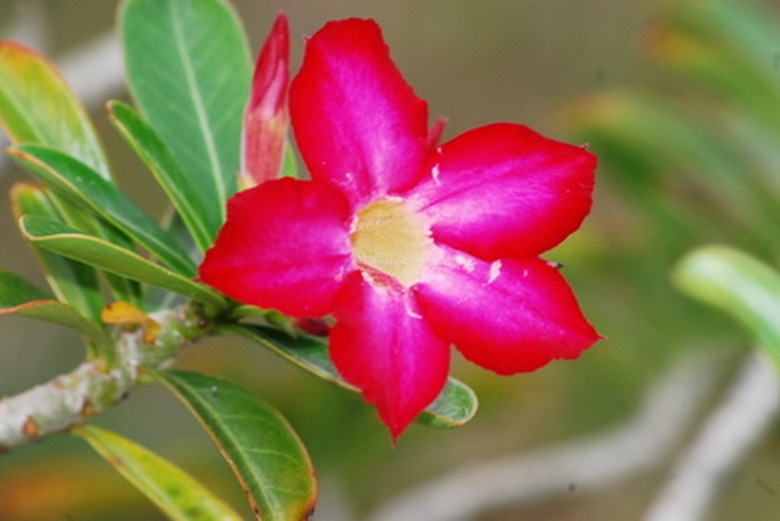How To Graft Desert Rose Plants
Things Needed
- Adenium obesum seedling, 1/2 inch stalk diameter
- Adenium obesum scion, 1/2 inch diameter
- Pruning saw
- Grafting knife
- Grafting tape
- Grafting wax
A native plant of sub-Saharan Africa and other desert regions of Africa and the Middle East, the Desert Rose or Kudu now grows as a container planting in many parts of the U.S. Many cultivars selected for bloom quality and color propagate only through rooted cuttings or grafted seedlings. Cleft grafting works well with this desert succulent, but the plant's tropical growth habits create some tricky timing issues for the home gardener.
Step 1
Saw off the top of the rootstock Desert Rose plant. Cut straight across, 4 inches above the swollen base of the stem. This swollen portion or caudex stores water for the plant and in seedling Adeniums tapers to a straight section. A proper cut leaves that caudex intact with 4 inches of straight stem above it.
- A native plant of sub-Saharan Africa and other desert regions of Africa and the Middle East, the Desert Rose or Kudu now grows as a container planting in many parts of the U.S.
- Many cultivars selected for bloom quality and color propagate only through rooted cuttings or grafted seedlings.
Step 2
Split the end of the rootstock stem exactly in half with the blade of the grafting knife, opening a split 3/4 inch deep in the stem's top.
Step 3
Cut a branch of the desired Desert Rose cultivar for scion stock. Scion wood comes from the plant you wish to duplicate, not from the rootstock. The scion should be the same diameter as the cut stem of the rootstock. Trim the scion to a 6 inch long section with at least three bud nodes. Discard the rest of the donor branch.
Step 4
Trim one side of the scion's base, starting 3/4 inch from the base and cutting straight to the center of the scion's end. Turn the scion over and make a matching cut on the opposite side. The two parallel cuts should meet in a sharp wedge with flat sides.
- Split the end of the rootstock stem exactly in half with the blade of the grafting knife, opening a split 3/4 inch deep in the stem's top.
- The scion should be the same diameter as the cut stem of the rootstock.
Step 5
Twist the split stem slightly open with the grafting knife and insert the trimmed end of the scion. Press the two sections together. Cambium layers on both sides of the scion should match up to the cambium of the stalk.
Step 6
Wrap from 1/2 inch below the graft upward to 1/2 inch above the graft with grafting tape.
Step 7
Seal any gaps in the covering–and any injured areas still exposed–with grafting wax. Remove the grafting tape in 6 weeks after the scion begins normal growth and the graft completely heals.
Tip
Adenium grower Mark Dimmitt of Tuscon Cactus reports best success grafting Desert Rose when the rootstock plant is actively growing. Since Adenium plants put on their first growth spurt in response to high seasonal humidity, graft in late spring or early summer, not during the plant's dormancy. Keep the Desert Rose in a warm humid location and out of direct sunlight while the graft heals.
Warning
Leaves and branch tips of Desert Rose may die back when temperatures drop to 40 degrees F. Storing dormant scions under refrigeration could be risky. Use extreme caution when working with Desert Rose, since the plant's sap contains poisons strong enough to tip the arrows of African hunters. Wash hands immediately after contact with the sap.
